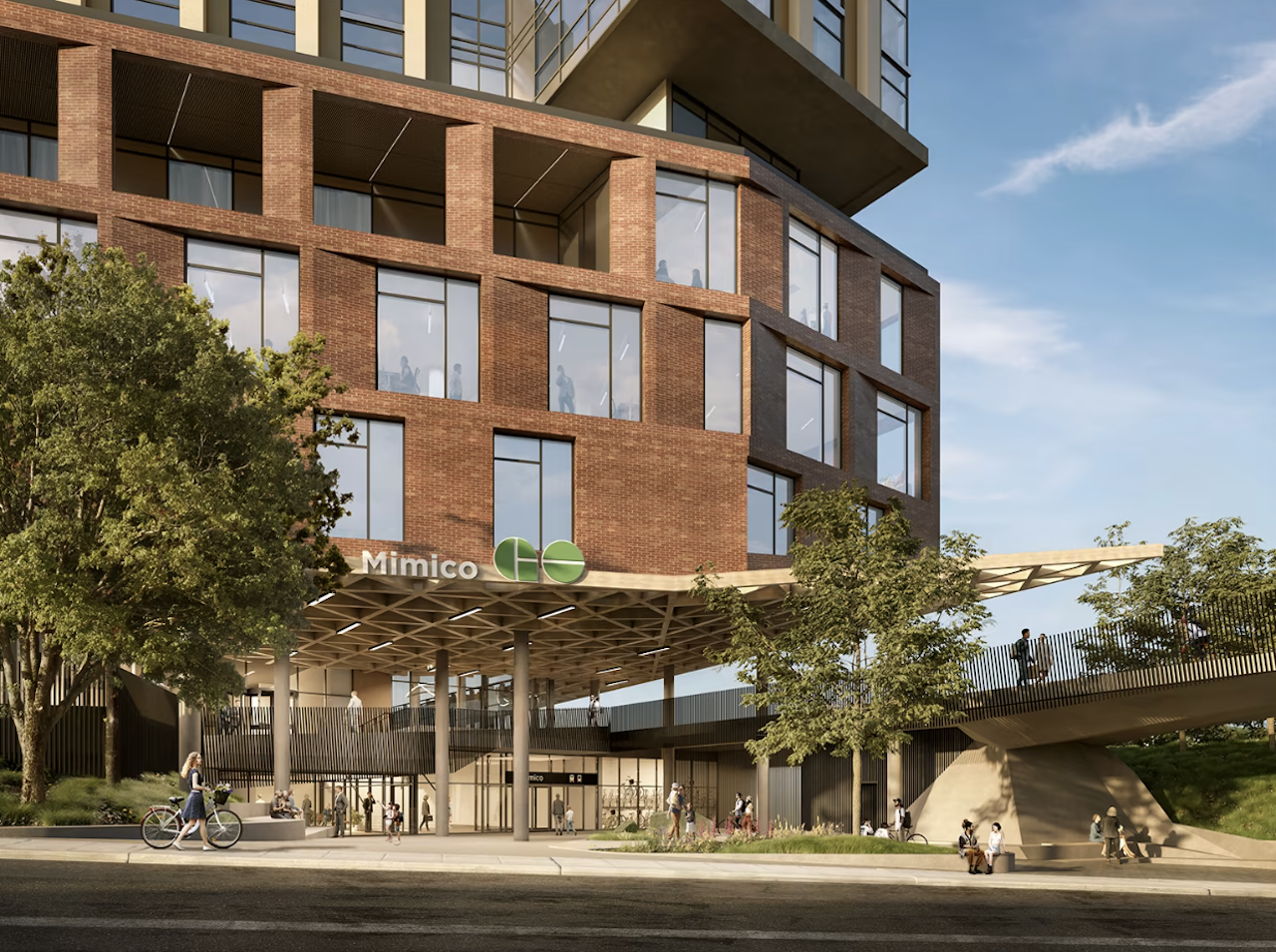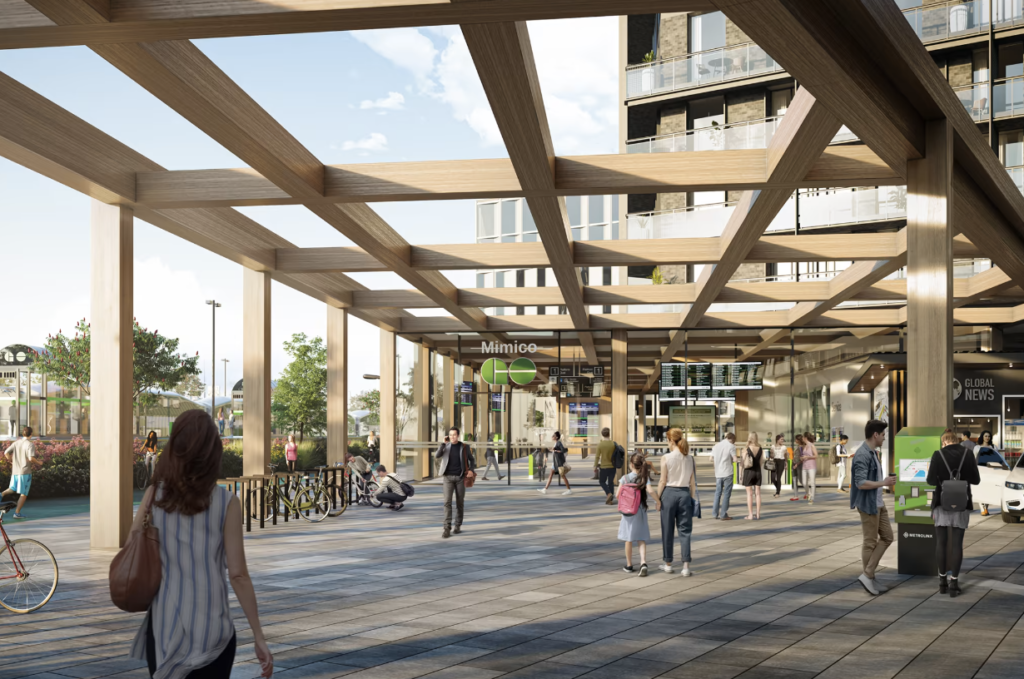
Transit Briefs: Metrolinx, PANYNJ, St. Louis MetroLink, Calgary Green Line LRT, SEPTA, BCT
Written by Carolina Worrell, Senior Editor
View of the station entrance off Royal York Road from street level. Artist’s rendering, subject to change. (Vandyk Properties image)
Metrolinx moves forward on transit-oriented community at Mimico GO Station. Also, the Port Authority of New York and New Jersey (PANYNJ) reports that quarterly PATH ridership climbed to 59% of pre-pandemic first-quarter 2019; MetroLink’s Secure Platform Plan progresses; Calgary’s Green Line names Bow Transit Connectors as Development Partner; the Southeastern Pennsylvania Transportation Authority (SEPTA) shares progress on strategic plan; and Broward County Transit (BCT) launches multi-billion-dollar Premium Mobility Plan (PREMO).
Metrolinx
Metrolinx announced May 1 that the transit-oriented community that will transform the Mimico GO Station area is “one step closer to reality.”
Last year Metrolinx and Vandyk Properties signed an agreement, which outlined the transit infrastructure improvements that the developer will be constructing. Since then, the two parties have been working together on the design and infrastructure requirements to deliver the station. Station improvements will include:
- Two station access points on the north side of the station.
- A new, fully accessible main station building.
- 300 underground, dedicated GO parking spaces.
- 96 spaces for bicycle storage, including secured and covered bike parking.
- An integrated transit plaza with pick-up and drop-off facilities.
- A greenway path for pedestrians and cyclists to access the station.
According to Metrolinx, the transit-oriented community at Mimico GO Station will provide an estimated 2,078 housing units, including affordable ownership and rental options, as well as new retail and office spaces in the rapidly growing south Etobicoke area.
As part of the municipal planning approvals process, Vandyk Properties has submitted a Site Plan Application (SPA) to the City of Toronto.
The first station access point will be on the north side of the rail corridor through a pedestrian bridge off Royal York Road. A secondary station access point will be on the north side of the rail corridor off Windsor Street with an accessible tunnel connection to access the station from the south side of the rail corridor.

Renderings show once construction of the station and surrounding area is complete, people who live, work, or visit the Mimico area will be able to “seamlessly connect” from GO Transit to new, integrated housing, retail and commercial spaces; amenities like secure bike parking and green spaces.
According to the agency, Metrolinx and Vandyk Properties will continue to advance the station design and determine a construction schedule. Design, construction, and safety standards will be incorporated into the final plans. Metrolinx will update the community as plans for the station improvements progress.
PANYNJ
PANYNJ has reported that during first-quarter 2023, ridership on the PATH commuter railroad rose to 11.3 million passengers, which was 59% of the ridership during the first quarter of pre-pandemic 2019. PATH’s quarterly ridership has steadily increased, with the second half of 2022 also hitting 54% and 57% of 2019 volumes.
In the month of March, PANYNJ says the railroad served a total of 4.2 million passengers, which was the first time that total ridership climbed above 60% of pre-pandemic levels, hitting 61% of March 2019 levels.
Additionally, the U.S. East Coast’s largest container port was the nation’s second-busiest port during the first three months of 2023, when the port moved nearly 1.8 million TEUs (20-foot equivalent units), like the amount moved during the same period in 2019, according to PANYNJ. The port’s continued strong volumes despite a national softening in cargo movement and its second-in-the-nation status during the first quarter of 2023 “reflect the port’s ability to retain the business and cargo growth that shifted in the past few years due to supply chain issues elsewhere in the country,” the Authority said.
In the month of March, the Port of New York and New Jersey handled 574,452 TEUs, making it the nation’s third-busiest port.
MetroLink
Bi-State Development on April 27 announced that progress is being made on the Secure Platform Plan, part of a “multi-tiered strategy to grow ridership and deliver a stronger transit experience by creating centralized, highly secure customer entrances at all 38 MetroLink stations, as well as the soon to be constructed MetroLink station at MidAmerica St. Louis Airport.”
According to Bi-State Development, the project has been divided into six construction packages comprised of four to eight MetroLink stations each. Stations have been selected for the first two packages. Package #1 includes the Jackie Joyner-Kersee Center, College, Emerson Park and Washington Park MetroLink Stations. The design phase for this package, Bi-State Development says, is on track to be completed this summer, which will allow for bidding for a construction contractor in late summer 2023. Construction at the four stations in this package is expected to be completed in Spring 2024.
The Forest Park-DeBaliviere, Central West End, Cortex, Grand, Union Station, Civic Center and Delmar Loop MetroLink Stations have been selected for Package #2 of the Secure Platform Plan. The design phase for this package is scheduled to be completed in Fall 2023, with construction at those seven MetroLink stations expected to be completed in Summer 2024.
According to Bi-State Development, Metro Transit has been “diligently collaborating” with design consultant HNTB to identify the most appropriate gating and fencing solutions for the Secure Platform Plan. HNTB’s primary recommendation of a roto-gate, complemented by a swing gate for ADA and emergency access was selected by Metro Transit. Following a comprehensive analysis and scoring criteria, welded-wire fencing was selected that provides both optimal security and visual appeal for MetroLink.
“This new infrastructure is the foundation of our Secure Platform Plan,” said Bi-State Development General Manager of Security Kevin Scott. “The new welded-wire fencing, roto-gates and swing gates will completely transform the MetroLink system, and in combination with new technology and 1,600 closed-circuit cameras monitored 24/7 through our Real Time Camera Center, we will provide our customers with a superior transit experience that is substantially safer and more secure.”
Calgary Green Line
The Green Line Board has approved the Development Phase Agreement for its LRT project and selected Bow Transit Connectors (BTC) as its Development Partner, following a successful procurement.
BTC brings together Barnard Constructors of Canada, LP, Flatiron Constructors Canada Ltd, and WSP Canada Inc, along with their financial advisor EllisDon Capital Inc. Collectively they will bring “shared expertise in underground, above-ground structures, and LRT design and construction to deliver Phase 1 of the Green Line LRT Project,” according to the Board.

This announcement, Green Line says, launches the Development Phase, which will “allow for collaboration, design progression, and agreement on project costs, risks, and overall schedule between Green Line and BTC, before signing a Project Agreement.” As part of negotiations, Green Line agreed to extend the Development Phase from approximately 12 months to 16 months to allow for greater design progression and cost certainty. The Implementation Phase remains on track to begin in 2024.
The Green Line remains a project “for Calgarians, built by Calgarians,” the Board said. In addition to the lead construction and design team, BTC is proposing its subconsultants which, to date, include Delve Underground, Platinum Engineering Ltd, Egis, IBI, GEC Architecture and Architecture 49. As additional agreements are finalized with the local contracting community, Green Line will share updates about the teams who will work with us through both the Development and Implementation Phases.
At 18 kilometers, Phase 1 is the longest LRT project and largest infrastructure investment in Calgary’s history, creating almost 20,000 jobs throughout construction, C$2.2 billion in long-term city-shaping benefits and more than C$6 billion in property value uplift by 2040.
“The selection of our Development Partner and launch of the Development Phase is an important milestone as we move forward with BTC to design, build and finance the Green Line LRT,” Green Line Board Chair Don Fairbairn. “The Green Line Board has confidence in BTC and their ability to work collaboratively as we collectively ensure we balance costs and risks with the long-term city shaping benefits of Green Line.”
“As part of the BTC team, we look forward to bringing our expertise in delivering large scale transportation projects to the Green Line LRT Project,” said Flatiron Constructors VP of Operations Ken Tanner. “We are proud to share the trust of the City of Calgary as we significantly improve mobility for Calgarians.”
“This is a crucial project for Calgary’s future,” said Barnard Construction Company VP Dan Schall. “As a partner of BTC, we will work collaboratively with the City of Calgary and local communities to deliver this exciting and important city-shaping project.”
SEPTA
SEPTA announced May 1 that the agency is “advancing the goals” laid out in its strategic plan, SEPTA Forward, and has published a new annual report on its progress.
Published in February 2021, SEPTA Forward “provides a framework for SEPTA’s recovery from COVID and fosters a resilient, prosperous, and equitable future.” The annual report (download below) examines the work that has been done to meet those goals.
“Looking back over the last several years, SEPTA has made incredible strides,” said SEPTA General Manager and CEO Leslie S. Richards. “Thanks to the dedication, ingenuity, and passion of our employees, we not only survived the most tumultuous time in our history–we are better, we are stronger, and we will continue to evolve to meet the needs of the region.”
The strategic plan is organized around three goals that work together to achieve SEPTA’s vision:
- “Develop a proactive organization: SEPTA is an agile and responsive organization that makes the most effective use of its resources by investing in its people and working to build a diverse, inclusive, and empowered workforce.
- “Provide an intuitive experience: The system is easy-to-use for all, regardless of familiarity, language, or ability, welcoming riders from across the world.
- Deliver a seamless transit network: SEPTA services work together, creating one unified, equitable network serving all types of trips.”
To track its progress, SEPTA established a set of organization-wide key performance indicators (KPIs) that are aligned with these goals. These KPIs, the agency says, will “help to guide investment decisions, identify areas for improvements, and create accountability internally and externally.” Regular updates are available here.
“I encourage everyone to review SEPTA’s Annual Performance Report to better understand our progress so far, and the steps we have taken to best steward our funds and enhance our operations,” said Richards.
BCT
BCT has officially launched its PREMO plan which, the agency says, will “forever improve the transportation landscape in Broward County.”
According to BCT, this initiative will add more than 200 miles of new premium transit services to its existing service network, including 1.5 miles of Commuter Rail, 23.3 miles of Light Rail Transit, 76 miles of Bus Rapid Transit, and 100 miles of High Frequency Bus Service with eight east/west corridors and six north/south corridors. It will also create new jobs, stimulate economic development, connect major points of interest, and provide Broward County residents and visitors with multimodal transit options. Over the past year, BCT has been studying transit needs and conducting public outreach to determine the best means to better connect people and places.
Corridor recommendations, BCT says, are based on current ridership, ridership potential, community feedback and economic development opportunities. “As more people fulfill their dream of moving to our beautiful county, traffic congestion continues to be a growing concern,” said County Administrator Monica Cepero. “It’s exciting what the PREMO plan will bring to our Broward County community and those that visit us. Being able to quickly travel from east to west and north to south while connecting directly to Broward County’s three major economic engines, our Airport, Seaport, and Convention Center is important to our future mobility solutions. This PREMO plan also offers us the opportunity to become one of the leading intermodal transit providers in the country.”
According to the American Public Transportation Association (APTA), investing in public transportation can create 49,700 jobs for $1 billion dollars invested and yield a five-to-one economic return for every dollar spent. Based on this statistic, the PREMO plan, BCT says, is projected to create thousands of new jobs. Coree Cuff Lonergan, General Manager/Director of Transportation of Broward County Transit said, “We are so excited to bring the PREMO plan to Broward County. This data-driven plan will not only improve the way Broward County connects through the 200 miles of new premium service, it should significantly increase annual ridership, stimulate economic development, support affordable housing, and expand small business opportunities.”
According to BCT, “the goals of the plan are simple and will have a major impact on the future of our county.” Goals include integrating and serving the community; improving mobility for all; implementing equitable transit solutions, safety and security; ensuring environmental stewardship; and enhancing economic development and ensuring financial stability.
According to World Population Review (2023) Broward County is the 2nd largest county in Florida and its population continues to rise. “With this plan, Broward County will have the framework and infrastructure to support this growing population and comfortably travel into the future,” BCT said.



